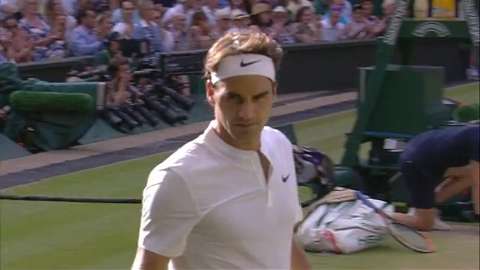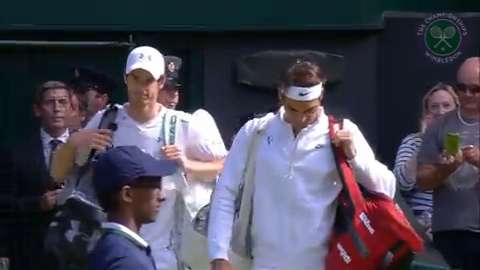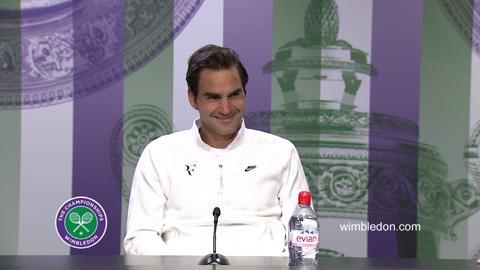In 2006, the late author David Foster Wallace came to Wimbledon to write an article about the No.1 tennis player in the world at the time. A little more than a month later, Wallace disgorged multiple thousands of words – many of them in tiny footnote type – on the subject in a soon-to-be-famous article for the New York Times Magazine called “Federer as Religious Experience”.
Despite its weighty premise, and a drastically shortsighted view of Federer’s budding rival at the time, Rafael Nadal, the piece became a classic, and has remained the defining view of the then-25-year-old Roger Federer at the peak of his career.
Of those multiple thousands of words, and the often-complex thoughts they contained, the ones that I remember best came in the final two sentences; they actually appeared after the article ended, in a footnote on the bottom of the last page. Wallace, writing as if he were sitting in Centre Court, summed up the experience of watching Federer with a simple appreciative thought, which doubled as an equally simple directive for the rest of us: “Just look at him down there,” he wrote of Federer in action. “Look at that.”
Definitely one of the best matches I've played in my career
On Friday, nearly a decade after Wallace gave us that advice, the tennis world was looking again at Federer on Centre Court. He’s 33 years old and a father of four now, and his peak years of dominance are behind him – at least they appeared to be behind him before today. If there was ever a “turn back the clock” match, it was Federer’s 7-5, 7-5, 6-4 win over Andy Murray in the Wimbledon semi-finals. The scores weren’t all that close, but they still make the match sound closer than it was.
This wasn’t a win as much as a dismissal. It began, I thought, with the two players’ walk onto the court. Federer led the way, his face a mask of impassive concentration. Murray followed, a little slump-shouldered, his baseball hat, which I hadn’t remembered him wearing over the course of this fortnight, robbing him of something – polish, gravitas, confidence, maybe. Normally you can’t read anything into a pre-match moment like this, but as Federer and Murray walked through the tunnel and onto the court, I didn’t feel like youth would have the advantage over age in this match. The older player looked to be the more convinced player.
And who would doubt that was the case now? From the moment that Federer saved a break point in the opening game with a service winner, to the moment, a little more than two one-sided hours later, when Murray missed a forehand on match point, Federer was in fully in charge of the proceedings and his surroundings. There was talk afterward that Murray had played as well as he could, and there was nothing he could have done. And that’s true to a degree; Murray would expect to win most matches in which he hits 12 aces and makes 74 percent of first serves. He also fought hard to stay above water in the final games of the second set, when the match was essentially decided and Federer was pressing him hard. Yet when Murray saved five set points, and brought the crowd to its feet, at 4-5, Federer came right back with a soul-crushing love hold to silence opponent and audience again.
Federer pounded 20 aces, made 76 per cent of first serves, hit 56 winners and committed just 11 errors, and, after the opening game, didn’t face a break point. He said later that it was one of the best matches he has ever played, and it was; yet it didn’t feel like a “vintage” performance, exactly. If the Federer of 2006, in his “religious experience” days, played rings around his opponents, on Friday he dictated, with force, from above.
He won the way Pete Sampras won at Wimbledon. By using his serve to rob his opponent of all hope – Federer had 11 aces in the first set – and then launching a quick strike to break at the end of each set. Even from the baseline, Federer’s game was a show of force. As Andy Roddick noted in the BBC commentary booth, Federer had no trouble taking a hard-hit ball from Murray, driving it back through the court, and gaining the advantage in a rally.
“Today I was clearly able to play very well from the start,” Federer said. “The beginning was always going to be an important part of the game. I had to save break point first, then I was able to start rolling on serve. Played a great game to break. So, I mean, definitely one of the best matches I’ve played in my career.”
If this win had a Samprasian feel for much of the way, it ended on a traditionally Federesque note. With Murray serving at 4-5 in the third set, and down 0-15, Federer ranged to his left in pursuit of a Murray crosscourt approach. It appeared that he wouldn’t get there in time to hit a standard pass, so he reached out with a backhand and did something better. He flicked the ball – it was nothing more than a flick – across his body and past Murray for an acutely-angled crosscourt winner.
It reminded me of the famous between-the-legs passing-shot winner that Federer slapped — with topspin — past Novak Djokovic at the end of the 2009 US Open semi-finals. Murray’s reaction was similar to Novak’s that day: He turned on a dime and dropped his head, looking like a defeated man even before the final point had been played. It was Federer’s way of putting an the exclamation point on one of the most resoundingly declarative afternoons of his career.
Twelve years after his first Wimbledon final, and nine years after his peak season, there’s still only one way to end a piece of writing about Federer when he’s hitting a shot like that, or winning a match like this.
“Just look at him down there. Look at that.”










































